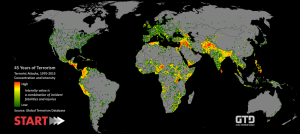This is a sad blog to write. But if those haunting images of terror attacks, being beamed almost on a daily basis now, is getting you increasingly worried about travelling, you need to know a few things.
Firstly, some stats. As per the US State Department statistics, there were close to 12,000 incidences of terrorism globally in 2015. Over 28,000 people were killed and another 35,000 people injured in these attacks. In 2014, over 93 countries experienced some sort of terrorist incident with 67 countries experiencing one or more deaths from terror activities. Clearly, the world is not a safe place and our fears have enough fodder.
Secondly, some perspective (or perverse logic). Much of the terrorism is highly concentrated to these five countries: Iraq, Nigeria, Afghanistan, Pakistan and Syria. One is 100 times more likely to meet with a fatal road accident. Overall, the chances of you getting caught in a terrorist attack are 1 in 20 million, according to this article. And, if you are a resident of India, statistically, your probability of facing a terrorist event would drop if you are visiting any country apart from those mentioned above. Grim, but true.

Citation: National Consortium for the Study of Terrorism and Responses to Terrorism (START). (2016). Global Terrorism Database [Data file]. Retrieved from https://www.start.umd.edu/gtd
The fact also is, when a place is only ever mentioned by the media in the context of terrorism, it gets associated with violence and fear. However, the ground reality is often very different.
To Go or Not to Go
Here are some things that will help you analyse your risks better and decide on whether a destination is safe for travel:
- Follow Travel Advisories: Perhaps, the best advice on travel safety is in the Travel Advisories issued by various countries. These are regularly updated, provide concise information on the risk areas and clear dos and don’ts. Check the US State dept. website here or UK website here. Other countries (and sometimes corporates) also issues such advisories. So make it a habit to do a quick google search – “Travel Advisory (your destination)” before any trip you undertake, even to innocuous destinations.
- Connect with Locals: A great and really simple way of getting some on-ground information is making use of travel websites that help you get in touch with locals. While Airbnb and Couchsurfing are the obvious ones, Be Welcome is a social network that helps you connect with locals who can give insider tips on navigating your way through a politically turbulent area. Other websites like TravBuddy and Travellers Point are also great tools to use to connect with other travellers and discuss and get advice on your travel plans.
- Study the History of the place: Most importantly, understand the history of a place – important dates in politics or dates of unrest, as with national events and religious festivals, and be mindful of the threat perception on those dates.
- Derisk your itinerary: Many times, the threat terrorism threat is localized to a particular geography of a country or big cities, while the rest of the country is largely seen to be unaffected. In these situations, it is always an option to plan a “lower risk” itinerary by carving out visits to higher threat areas.
- Take basic precautions: Some basic precautions can go a long way in avoiding and managing dangerous situations:
- Avoiding the main airports, as much as possible
- As far as possible, and this is a tough one, avoid large gatherings around planned events, especially open to general public.
- Staying in smaller or secluded resorts
- Dressing like a local to avoid undue attention
- Keeping your country’s embassy and consulate phone numbers as also other emergency numbers handy and stored in your mobile phone
- Keeping in touch with friends and family as much as possible through whatsapp, emails as also various apps (see our blog on such apps here)
In the end, incidents of terrorism are meant to propagate fear and intolerance, which is exactly what travelling counters and therefore, travel is a small but sure way of battling this global problem. We live in an increasingly unsafe world and just like our everyday activities don’t halt at the behest of global tragedies, nor should our will to experience new places, people and cultures. Travelling is like an open defiance to bow down to the environment of fear that such acts intend to propagate. We all have been affected, in one way or another, by terrorism but it’s important to keep sight of the reality of the situation rather than get bogged down by the insecurity and fear.
Would love to hear your comments and suggestions on we can all Travel Safe and Travel Equipped!



BRAGPACKER
Tragic, heart wrenching attack in the beautiful city of Nice, France today morning. Terrorists attacked the Promenade des Anglais where crowds had gathered for Bastille Day celebrations.
Unfortunately, this adds to the several recent examples of terrorists attacking gatherings and popular tourist events/ places.
Our heart goes out to the people of this lovely city and families of those affected by the attack. God bless!